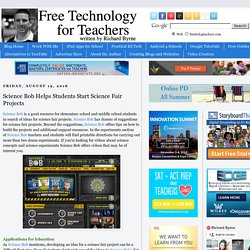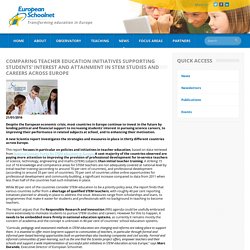

El juego de cartas “Top Female Scientists” Top Female Scientists es un juego de cartas desarrollado en 2015 por Hannah Wakeford y Simon Clark para The Science Hour on XpressionFM en la Universidad de Éxeter. Esta baraja pretende rendir homenaje al sobresaliente trabajo realizado por las mujeres en el campo de la ciencia a lo largo de la historia. Se propone fundamentalmente como una herramienta para el aula, para animar a las niñas a interesarse por la ciencia. La baraja está compuesta por treinta y dos cartas correspondientes a otras tantas mujeres relevantes en los campos de la biología (seis), la geología (seis), la física (siete), las matemáticas (siete) y la química (seis).
Cada carta contiene el nombre y una imagen de la mujer elegida, los años de su nacimiento y su defunción, el área o áreas de la ciencia a los que se ha dedicado, una breve biografía y cuatro características –puntuadas– relativas al trabajo o la personalidad de estas científicas –innovación, impacto, oscuridad y genialidad–. Cómo se juega Biología Física Química. Over 60 Great Resources for STEAM Teachers. May 13, 2017 A few months ago we published a visual that features 20 websites perfect for STEAM (Science, Technology, Engineering, Art, and Math) curriculum.

Today we stumbled upon this interesting resource from OER Commons that offers over 60 educational materials teachers can use to design their own STEAM curriculum. Each of these materials come with a short abstract on what it is and how you can use it in your lessons. It also provides information regarding grade level it can be used with, subject area, language, media type, accompanying activities, and many more. While almost all of these lessons are provided under a CC license, you need to make sure you read conditions of use and ‘Use Guideline’ which are usually found on the lefthand side of the lesson page. You can search for STEAM lessons in OER Commons by subject, educational level or standard.
10 of The Best Chrome Apps for Math Teachers. Here is what we have been working on over the last weekend.

This is a list that comprises some of the best math apps and extensions in Chrome store. We have literally gone through hundreds of apps to finally decide on the apps that would make the cut.These extensions are meant to help kids develop math skills through a wide variety of exercises, activities, games, interactive simulations and many more. Some of these apps are integrated with Google Drive and are also available for iPad, Android, and Chromebooks. 1- GeoGebra GeoGebra (www.geogebra.org) is free dynamic mathematics software for all levels of education that brings together geometry, algebra, spreadsheets, graphing, statistics and calculus in one easy-to-use package. 2- Desmos Graphing Calculator Explore math with Desmos!
3- Math Arcade Games Improve your math skills and have arcade style fun at the same time. Science Bob Helps Students Start Science Fair Projects. Science Bob is a good resource for elementary school and middle school students in search of ideas for science fair projects.

Science Bob has dozens of suggestions for science fair projects. Resources Gallery. Here Is A Great Website for STEM Teachers and Students. May 1, 2016 NOVA, one of the popular American TV series that produces in-depth science programming in the form of documentaries and short videos, has this excellent resource called NOVA Education.

This is a free portal designed specifically to cater to the teaching and learning needs of STEM teachers and students. It provides a wide variety of educational materials that include informative short-form videos explaining different scientific phenomena, lesson plans to appropriate for your own teaching situation, interactive and several other resources all aligned to teaching standards. You can use the site’s search box to quickly locate a video or browse through the content of NOVA Education by topic. There are four main topics: Life Science, Earth and Space Science, Physical science, Technology and Engineering. Each of these topics includes a number of subtopics. Science in School. Detail. Despite the European economic crisis, most countries in Europe continue to invest in the future by lending political and financial support to increasing students' interest in pursuing science careers, to improving their performance in related subjects at school, and to enhancing their motivation.

A new Scientix report investigates the strategies and measures in place in thirty different countries across Europe. This report focuses in particular on policies and initiatives in teacher education, based on data retrieved from National Contact Points for STEM education in Europe. A vast majority of the countries observed are paying more attention to improving the provision of professional development for in-service teachers of science, technology, engineering and maths (STEM) subjects than initial teacher training.
The report argues that the Responsible Research and Innovation (RRI) agenda could be usefully embraced more extensively to motivate students to pursue STEM studies and careers. 14 cuentas de Twitter sobre STEM que no debes perderte (@balhisay) El desarrollo de la competencia STEM (en el inglés original Ciencia, Tecnología, Ingeniería y Matemáticas, por si es la primera vez que te encuentras con este acrónimo) plantea el reto de abordar con un enfoque holístico el trabajo en estas cuatro áreas de conocimiento.

Las tendencias educativas internacionales claramente se inclinan hacia la promoción de esta visión integrada con el propósito de estimular el talento en áreas productivas que hoy son claves para la mejora de la competitividad de los países. Incluso hay una iniciativa que incluye las artes en una ampliada competencia STEAM (puedes encontrar algunos ejemplos muy interesantes en Proyectos STEAM: crear para aprender), algo que aún se nos antoja más lejano a la realidad de nuestros centros al combinar humanidades y tecnología.